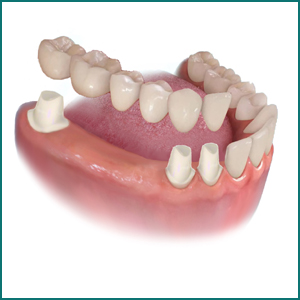
Dental Prosthesis
It is a field of odontology responsible for the rehabilitation of missing teeth, through fixed, removable and implant-supported prosthesis, recovering esthetics, phonetic, and chewing functions of the mouth.
How would I know which type of prosthesis is the right one in my situation?
Two procedures will be needed: an initial evaluation and imaging test (radiography and/or tomography) to be able to plan the case and, in this way, define which are the better treatment options.
Why must the missing tooth be replaced?
For the perfect performance of its functions, teeth need to be in balance in the dental arch.
The absence of a dental piece may cause problems such as joint pain, malocclusion generated by dental movement, difficulty in chewing, aesthetic and phonetic problems, thereby affecting health in general.
Types of dental prosthesis
Basically, there are 3 types of prosthesis: Fixed prosthesis, removable prosthesis, and implant-supported prosthesis.
What is a fixed prosthesis?
They are prostheses that replace one or more missing teeth, supporting themselves on roots of neighboring teeth. They are also known as fixed bridges, crowns, etc.
They receive the name ‘fixed’ because they cannot be removed by the patient or the odontologist unless they are cute with the use of special drills. They can be confeccionated with cosmetic materials (acrylic or porcelain) or not (metal).
What is a removable prosthesis?
It is a prosthesis that replaces missing natural teeth, in a partial (Removable partial prosthesis or movable bridge) or total manner. It is called removable because it can be withdrawn by the patient any time they wish to do so.
What is an implant-supported prosthetic?
It is a prosthesis that replaces one or more missing teeth, supporting themselves on artificial roots, called implants. They can be fixed or removable. For the fixed prosthesis, the implants will work as if they are natural roots. Whilst for removable prosthesis (called overdenture), the implants will offer better retention, stability, and esthetic, increasing efficacy and security.
And during the treatment?
You will use an appropriate provisional protection (provisional prosthesis) that will allow you to chew, talk, and smile satisfactorily during the treatment.
Dr. Manuel Amarilla
Reg. Prof. Nº: 4121
Specialist in Aesthetic Dentistry
